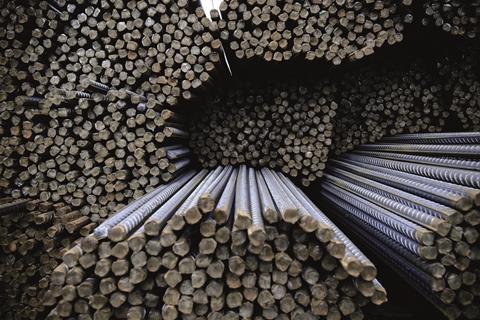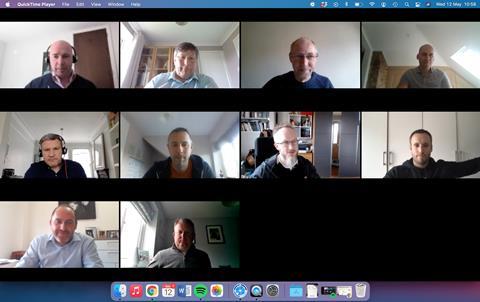Gathering and analysing data on materials availability across the supply chain can greatly improve efficiency on construction projects. Building, with decision intelligence company Peak, gathered industry experts to discuss how good data can help the sector meet its challenges

Welcome though the post-pandemic recovery across the construction sector is, the flurry of activity is inevitably piling pressure on the UK’s building materials supply chain, resulting in manufacturers and suppliers struggling to keep pace with demand.
According to the Construction Leadership Council (CLC) and other industry organisations, lead times have lengthened for most building products as developers begin to revisit schemes delayed by the pandemic, while materials firms are reporting finding it hard to build up stock levels.
With this in mind, it is even more important for the sector to consider the benefits that can arise from collecting and analysing data through the supply chain, looking at the availability and flow of materials to a particular project, and understanding how this information can best be utilised.
Together with decision intelligence company Peak, Building gathered together a group of industry experts in a virtual setting to discuss how data and artificial intelligence (AI) can be catalysts for effective and positive change, and how their application can help meet the challenges facing the construction sector, both now and in the future.
Data as a game-changer
Set against the background of the pandemic and in the light of current materials shortages, data and AI can be significant game-changers for the construction sector. Mark Perkins, construction territory lead at Peak, argued that making better use of data through artificial intelligence can be transformational for builders merchants and manufacturers.
Not only that, it offers an opportunity for all parties – designers, suppliers and contractors – to collaborate in order to improve the experience for customers as well as grow their own revenues.
Jonathan Earl, national commercial and logistics director at Tarmac Building Products, said many of his customers assumed he had an endless supply of products.
Forecasting and getting the right data is absolutely key – and so is how we use data to drive accurate product delivery
Jonathan Earl, Tarmac Building Products
With demand going through the roof, he said, inventory planning and management relied even more on accurate forecasting. “It’s becoming an education piece. Forecasting and getting the right data is absolutely key – and so is how we use data to drive accurate product delivery.”
Faced with unprecedented levels of demand, accuracy of data is extremely important, but it is here that some have encountered a further challenge. While suppliers strive to keep customers informed, problems can arise when different systems fail to “talk to each other”.

Andy Mudie, head of marketing at Etex Building Performance, said a lot of his customers were embarking on a digital journey, and that while they were in a transition phase there was the potential for confusion.
“Part of our role is to make sure whenever we introduce new systems or portals our customers are aware of the overlap with their current systems, so that if they’re trying something new everyone is making sure that interacts effectively with our systems.”
According to Damian Brewis, IT change director at Travis Perkins, it is a case of avoiding piling up too much data that people won’t really use and which slows down the system.
Greater sharing – and availability – of information is the goal, he said. “It would be better if we could communicate more seamlessly between organisations. That way the data can be utilised more quickly.”
More efficient and responsive
Felipe Manzatucci, director of digitalisation at Skanksa, sees data as being the catalyst for making the construction sector safer, greener, more cost efficient and more responsive to clients’ needs. “We’re trying to learn more about, or become better at engaging with our supply chain. How we engage, how we share data, how do we connect it; how does it get used?”
When the data is there, having visibility within a common system around product availability can be very useful, he added. Having a variety of repositories for data is a challenge for the industry. “I would like to see a more practical and beneficial way to share data.
It would be better if we could communicate more seamlessly between organisations. That way the data can be utilised more quickly
Damian Brewis, Travis Perkins
“Another challenge we’re finding is where the data sits, who owns it, who maintains it. We are now choosing to move away from third-party data repositories. We’re realising that data has value that our customers tap into.
“That’s where we wonder, as a tier 1 contractor, how we can help the industry to play on a level playing field – one where we are supporting that sharing of data. I’m keen to understand more. What is it that we can do to work with data in a collaborative manner?”
In response, Etex Building Performance’s Mudie said it depended on what type of information was being looked at –“whether it’s more of the transactional information, such as logistics and delivery, or it’s more of the design side”.
Mudie wondered if it would be possible to create a collaborative space where everyone would put data and where differences in a project could be highlighted.
“I think design detail from the front-end manufacturer through to the end of the project is really important, because if you get that part right it makes a lot of the actual construction easier.
“And if people can look at or work in the same operational space and look at the design together it can work well.”
Data integrity is vital
For those looking at putting in a commercial offer for work – and that is pretty much everyone – it is vital to go through a robust, transparent tender process in which early collaboration and engagement will be key, according to Tarmac’s Earl.
“We need as much accurate detail as possible on the credentials you’re looking for, not just from a quality service viewpoint, but also aspects of sustainability, what the carbon footprint is.
“I can’t stress enough how important the integrity is of the data that’s coming in. It enables you to get a huge insight into the project and its delivery.”
Forecasting is another hugely important aspect of setting up a project, but here too there can be issues. As James Morgan, head of innovation and marketing at Forterra, explained: “We get forecasts from some of our bigger customers. The challenge is that forecast is by no means fixed. It wanders about all over the place.”

It’s not that the data is incomplete or incorrect, rather that the construction process makes it by nature hard to predict, according to Morgan. “The data is correct for the day that the person pressed ‘save’ on the spreadsheet, but in the time it’s taken to email it across and translate it into our forecasting system it’s become wrong. The build on site A has been delayed, the build on site B has accelerated, we need more of product C on site D - and suddenly the world’s on fire.”
Access to real-time data could have an important role to play in the decision-making process once work had started, said Skanska’s Manzatucci. “If it’s going to be too windy to do something over there, can we something else over here?
“We don’t want delays, basically. We want to be able to say to all our supply chain: ‘This is the current performance or the current situation of our contract and here is an opportunity that has been identified to move the programme forward by a couple of days’.”
Changing business models
While the industry is awash with talk about the fragmented nature of the industry, change can only come about through a different business model, argued Matt Bennion, CEO of Reds10.
“We need to look to vertically integrate the delivery process more. We want our buildings to be delivered faster, cheaper, better, lower carbon – but to do that, to standardise elements of what you’re doing, you need to integrate those elements of the supply chain where you can.”
Part of the solution lay in more direct engagement with suppliers and more ownership for the work that was being delivered, Bennion added.
“There are lots of clever things that we can do with systems, and we can get one system to talk to another. But, fundamentally, we’ve got to remove layers of the treacle in the middle.”
Using the data on the operation of our buildings and combining that with organisational data from our clients’ businesses, we’re able to start to spot trends
Matt Bennion, Reds10
The question arose during the discussion as to whether AI could indeed bring together the disparate elements of the building materials supply chain and help produce a common language that would be available for everybody to use, in order to do the heavy lifting behind the scenes.
Peak’s Perkins said AI was very good at processing data more quickly, more accurately than a human could. “And the more data that you throw at it – provided it’s the right data – then the better the results get.”
AI could understand operational data such as forecasting, and then be supported by external data sources such as planning information and weather forecasts, Perkins added.
“It allows me to say, ‘Okay, we might have limited materials and limited production capacity, but we should allocate our products to this particular customer because we know they’ve got the highest growth potential’. Or ‘we know that can get these vehicles to get these products to a certain customer in this region, and do it more effectively’. AI is very good at spotting those different variables.”
Bridging the gap
The role of AI for builders merchants, which deal with both suppliers and end users, was spelled out by Travis Perkins’ Brewis. “At the moment the majority of the UK merchant industry is based around human relationships. And that’s hard to navigate away from.
“But there is a growing segment which has taken their experience of their day-to-day lives with IT and social media, and now wants that translated into their professional lives. AI and data can play a role in bridging the efficiency expectations of our customers.”
Brewis acknowledged that his and other firms needed to make sure people were prepared for the challenges they could face on such a journey. “I love technology, but I’m also very conscious that our people and our customers have to be in for the ride as well,” he said.
Whereas two years ago people didn’t understand AI very well, now there is a greater awareness and the conversation begins with them asking ‘Where do we start?’
Mark Perkins, Peak
Meanwhile AI could play a significant role in the working practices of manufacturers. Reds10’s Bennion said his team had taken all of the data that currently flows from individual components in a building and developed an operating system for low carbon operation of buildings.
“Using the data we’re starting to gather on the operation of our buildings and combining that with organisational data from our clients’ businesses, we’re now able to start to spot trends.
“Our next step is to look at automating that, so that the control of the building will ultimately be supported by machine learning which will identify when certain trends are happening and will adjust the internal environment to changes in internal use, or the external environment of the building, and try and remove as much of that human interface as possible.”
Bennion also said it would helpful to create “a more open environment to have more of that data surfaced and exposed in order to enhance the operating system that we put together”. Providing this sort of transparency would ultimately lead to better-quality buildings, he believed.
“It’s easy for the contractor to blame the operator of the building when things go wrong. But you can’t just leave the key in the shed any more and walk away at practical completion. You have to stand behind the performance of your buildings.”
Some manufacturers and suppliers might baulk at sharing information that could show there is potentially faulty equipment in a building, Bennion conceded, but such co‑operation would help make better buildings. “We want to deliver high-performance buildings that last the distance, that are efficient and support the productivity of the end user.
“We have to be transparent about that and take our clients on a journey, as well as also learn about those things that aren’t perhaps working in some of our design details, or some of the systems and components that we use, to make sure that we change those in our standard designs. You can’t do that by being secretive.”
Such openness could help in product development too, said Etex’s Mudie. “The more data you have, the greater access – along with information from the end user or owner operator – helps us. Because we can find areas where we can possibly work together to say if that was done a different way, maybe this could have been a better solution overall for everybody.”
The pandemic impact
Meanwhile the pandemic that has shaken construction to its core has prompted a surge in e-commerce. In the realms of data and information gathering, invaluable lessons have been learned.
Forterra’s James Morgan said covid had simply “lit the blue touchpaper”. Look at the housebuilders, he said, and how they’ve adapted to doing show rounds and allowing customers to specify and reserve a home online. “Just 12 months ago, that wasn’t happening. And now for those guys it’s quite normal.”
Morgan said he believed that having accelerated from a commercial side, the digital journey was now cascading down through organisations, into the supply chain, and into the build programme.
“It means we as a manufacturer need to be close to our customers to understand to help them and to adapt alongside them,” he added.
While the covid pandemic has been a catalyst for the industry to do things differently, AI had already been making its presence felt for some time, according to Peak’s Perkins. “AI is happening now. It’s not something that’s like robots in the future.
“Some industry sectors are more advanced than others and yes, the construction’s supply chain is slow to catch up. But whereas two years ago when you talked about AI, people didn’t understand it very well, now there is a greater awareness and the conversation begins with them asking ‘Where do we start?’.”
Round the virtual table
- Matt Bennion, CEO of Reds10
- Damian Brewis, IT change director at Travis Perkins
- Jonathan Earl, national commercial and logistics director at Tarmac Building Products
- Felipe Manzatucci, director of digitalisation at Skanksa UK
- James Morgan, head of marketing and innovation at Forterra
- Giancarlo Morini, commercial manager at Peak
- Andy Mudie, head of marketing at Etex Building Performance
- Mark Perkins, construction territory lead at Peak
- Jason Shingleton, marketing and development director at Genuit Group (formerly Polypipe)
- Roundtable chair: Thomas Lane, group technical editor, Building magazine


























